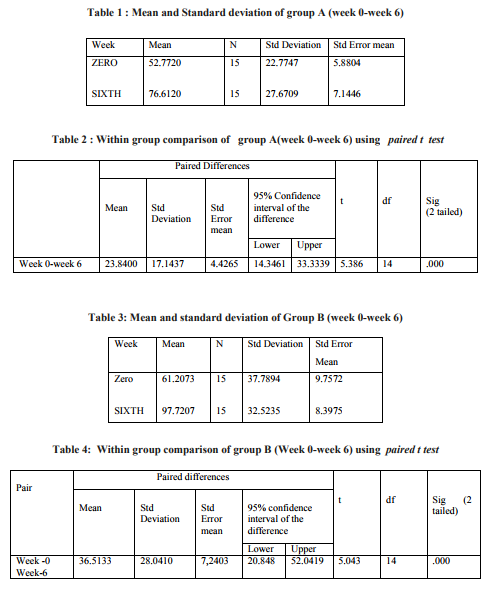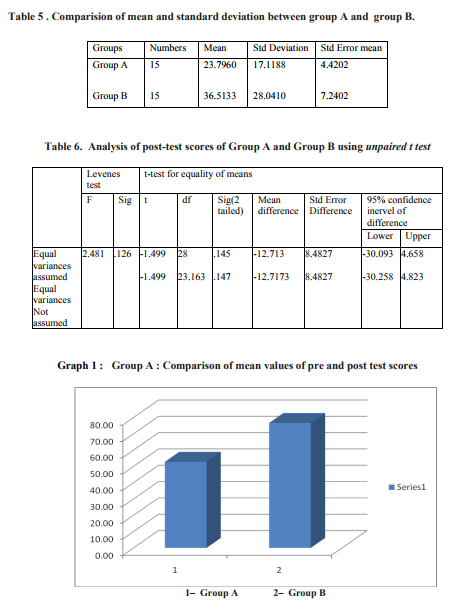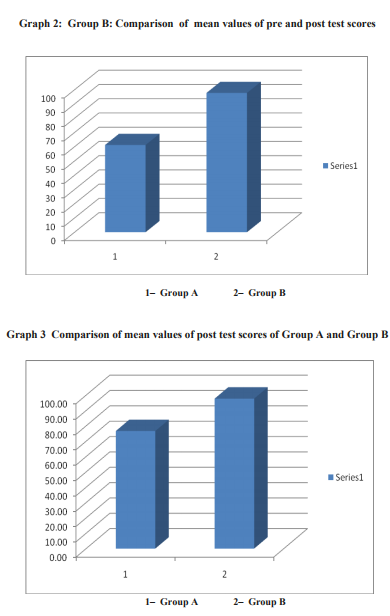IJCRR - 3(3), March, 2011
Pages: 34-41
Print Article
Download XML Download PDF
EFFECT OF CORE STABILIZATION EXERCISE ON A TRUNK EXTENSORS ENDURANCE TRAINING
PROTOCOL
Author: Sasidharan Tapan MPT, Shah Sonam BPT, B Harilal MPT , Lende Shailendra MPT
Category: Healthcare
Abstract:Objective: The objective of the study was to find the effectiveness of core stabilization exercises over a
trunk extensor endurance training protocol (TEEP) in improving trunk extensor endurance.
Methods: 30 physiotherapy students in the age group of 18-23 from KJPCP were conveniently selected
and randomly allocated to a control and experimental group having 15 subjects each. Experimental group
was given a trunk extensor endurance protocol along with a core stabilization program and control group
was given only TEEP. Both exercises were given for half an hour each, 6 days a week, for 6 weeks.
Results: It was found that core stabilization exercises along with TEEP is not significantly different from
trunk extensor endurance training protocol alone in improving endurance of trunk extensors.
Conclusions: TEEP protocol alone is effective in improving trunk extensor muscle endurance and its
combination with core stabilization exercises will not produce any significant improvements over use of
TEEP alone.
Keywords: Trunk extensor endurance training protocol (TEEP), core stabilization exercises, Modified Sorenson test.
Full Text:
INTRODUCTION
Muscular endurance is the ability of an isolated muscle group to perform repeated contraction over a period of time, with intensity of the activity being moderate. 1 It is one of basic elements of muscular performance that has great relevance to activities of daily living, lifting and bending in which the ability of trunk extensor to resist fatigue being important in industrial setting2. Poor endurance of trunk muscle may induce strain on passive structure of lumbar spine and hence result in low back pain[1,7]. Muscle has already been identified as a potential source of low back pain[4,5] as failure to protect passive structure from excessive loads may result in damage to pain sensitive structure and produce pain[6,7,12]. Endurance of lumbar stabilizer is a very important key for preventing lumbar pain[,8,9,10].Trunk muscle endurance training has been recommended as means of increasing fatigue threshold and improving performance and reducing disability.[11] Improving endurance of trunk extensor therefore appears to be sound and promising approach for preventing low back pain and hence justification for conducting this study among individual without low back pain[12,20,21] . The trunk extensor training protocols used in previous studies focused extensively on erector spinae composed of longissimus and spainalis, that is on a mobilizer of trunk at expense of stabilizers such as transverse abdominis and multifidus that are affected majorly in individuals with back pain[13,22] . Even though core stabilization exercises are being used widely in clinical setting its effect on dynamic stabilizers of spine remains unexplored. Trunk extensor endurance training protocol may need to be used in conjugation with specific stabilizing exercise of multifidus and transverse abdominals for a better result in back problems in patients. Core stabilization exercise through effective abdominal training is supposed to increases ones strength and stamina. So the training of trunk/ spinal stabilizers is therefore supposed to help in improving the endurance of trunk extensors or mobilizers and preventing potential development of backache in the future. It would of great importance if core stabilization programs with the emphasis on abdominals are found to have an effect on extensors of spine. Thus the purpose of this study is to investigate whether the application of core stabilization exercise along with a trunk extensor endurance protocol can improve trunk extensor endurance than the use of extensor training protocol alone in apparently healthy subjects.
MATERIALS AND METHODOLOGY
Materials
1. Rectangular Wooden Box (80x50x20.3cm)
2. Stop Watch
3. Weighing scale
4. Height meter/inch tape
5. Velcro Straps
6. Two pillows
7. Data collection sheet and pen
Methodology 30 normal healthy subjects from the campus of K.J.P College of physiotherapy within the age group of 18-23years were recruited for the study, on the fulfillment of inclusion criteria. A two group pre-test-post-test non randomized controlled trial design was used for subjects being recruited through convenience sampling. The study procedure and rationale were explained to subjects and their informed consent of participation obtained. Subjects were conveniently recruited but randomly assigned into either a controlled or experimental group by asking them to pick a piece of paper on which either E (experimental) or C (control) was inscribed. Age as on last birthday and gender were noted while their body weight and height were measured and recorded using standardized procedures. Their Body Mass Index was then estimated as weight in Kilo grams divided by height in meters square. The subjects in experimental (B) group were given a standard trunk extensor endurance training protocol (TEEP) previously used by Babatunde O.A et al (2007)14 , 4 days a week along with core stabilization exercises for the same number of days. Five standard core stabilization exercises, with the emphasis on abdominal activation, as given by „Therapeutic exercises?, 5th ed were used. All the exercises were started in supine hook lying position. First exercise was abdominal activation using „drawing in? procedure as in standard core stabilization methods. Second exercise was hip knee flexion extension of alternate legs up to 90 degrees of knee flexion, dragging the feel on bed. Third exercise included flexion extension of alternate legs, without dragging, up to 90 degrees of hip knee flexion. Fourth exercise was flexion extension of both legs together up to 90 degrees of knee and hip flexion without dragging of foot. Fifth exercise was straight elevation of lower limbs up to 45 degrees. In each exercises abdominals were contracted for 10 seconds. Each exercise was repeated 25 times per session in subject?s comfortable speed and those who required for break were given a single break of 30 seconds during each exercise. In between different exercises each subjects were given 1 minute rest. Duration of each exercise was between 25-30 minutes per day. The control (A) group had under gone only TEEP for the same duration and number of days. The outcome measure was the trunk extensor muscle endurance (TEME) using modified Sorenson test. TEME of both groups were calculated on day 1 and after 6th week. And the 6 th week score of both E and C groups were also compared.
Statistical methods Statistical test used was student?s t Test. With in groups Pre and post test scores were compared using paired t test and In between group pre and post test group scores were compared using unpaired t test. Level of significance was kept at 0.05. Data was analyzed using SPSS version 14.
RESULTS
Pre test scores didn?t show significant difference between two groups proving the homogenicity of the groups..Group E did show significant difference between pre and post test scores(t=5.043 sig=.000 ).Similarly group C also did show significant difference between pre and post test scores(t=5.386,sig=.000).But on comparison of post test scores between two groups, it was found that there were no significant differences(t= -1.499 ,sig=.145).
DISCUSSION
From the analysis it was seen that there was significant difference between pre test- post test scores of both groups but no statistically significant results were found between the post test scores between the group A (TEEP) and group B(TEEP + core stabilization) . The reason for insignificant difference would be that core stabilization exercises might not be so much effective in improving trunk extensor endurance of normal population either because of the inability of normal subjects in proper activation of core stabilizers or the duration of study might not be so much effective in getting results in normal healthy population. The study was conducted for four days weekly for one and a half month taking less than half hour per day, so there may be need to increase the duration of the study to get a statistically significant outcome in normal healthy population over a trunk extensor training protocol. In the study conducted by Cairns, Mindy C.; Foster, Nadine E.; Wright, Chris on September 2006 it was concluded that there was no effect of core stabilization exercises on recurrent low back pain[15,23]. That study used 2 groups: conventional, physiotherapy consisting of general active exercise and manual therapy; and conventional physiotherapy plus specific spinal stabilization exercises. Both groups showed improved physical functioning. No statistically significant differences between the 2 groups were shown for any of the outcomes measured, at any time and there was no additional benefit of adding specific spinal stabilization exercises to a conventional physiotherapy package for patients with recurrent LBP. Similarly when studies were conducted on healthy subjects it was concluded that there was no effect of core stabilization on trunk extensors. George A Koumantakis, Paul J Watson and Jacqueline A Oldham on March 2005 examined the usefulness of the addition of specific stabilization exercises to a general back and abdominal muscle exercise approach for patients with sub acute or chronic nonspecific back pain by comparing a specific muscle stabilization–enhanced general exercise approach with a general exercise. But there were generally no differences between the 2 exercise approaches for any of their outcomes other than self reported disability16 . They concluded that a general exercise program reduced disability in the short term to a greater extent than a stabilization-enhanced exercise approach in patients with recurrent nonspecific low back pain. The mode of action of stabilization retraining still remains unclear, because it has not been shown to be capable of mechanically containing an unstable segment, even upon improvement of muscle activation. Stabilization exercises do not appear to provide additional benefit to patients with subacute or chronic low back pain who have no clinical signs suggesting the presence of spinal instability. Similarly in healthy subjects correct contraction of the stabilizing muscles could not be achieved initially and subjects had to be constantly corrected by the treating physical therapist also each time new exercises were introduced[17,18] . This too can be attributed to the minimal effect of core stabilization excercises on the experimental group. Professor Eyal Lederman in his article „myths of core stabilization? Concluded that Core stability exercises are no more effective than, and will not prevent injury more than, any other forms of exercise. Core stability exercises are no better than other forms of exercise for back care19 . In the light of existing literature it can be easily concluded that core stabilization exercises have controversial validity and their inability to produce significant changes to trunk extensor endurance in normal healthy population in comparison to a specific trunk extensor endurance training protocol is well in sync with their controversial validity.
ACKNOWLEDGEMENT
All the authors would like to express a deep sense of gratitude towards the head of the physiotherapy department, Sumandeep University, Vadodara for his seamless support and encouragement and we would like to extend our gratitude towards the university management and entire staff of physiotherapy department for providing us with the all necessary facilities.



References:
1. Hui L, Ng GY, Yeung SS, et al. Evaluation of physiological work demands and low back neuromuscular fatigue on nurses working in geriatric wards. Appl Ergon 2001; 32:479– 83.
2. Mayer T, Gatchel R, Betancur J, et al. Trunk muscle endurance measurement. Spine 1995; 20:920–7.
3. Lavangie P, Norkin C. Joint Structure and Function: A Comprehensive Analysis, 3rd edition. Philadelphia: FA Davis, 1992
4. Biering-Sorensen F. Physical measurement as risk indicators for low-back trouble over a one-year period. Spine 1984;9:106–9. 17:121–7.
5. Mannion AF, Dolan P. Electromyographic median frequency changes during isometric contraction of back extensors to fatigue. Spine 1994;19:1223–9.
6. Mannion AF, Dumas GA, Stevenson JM, et al. The influence of muscle fiber size and type distribution on electromyographic measures of back muscle fatigability. Spine 1998;23:576–84.
7. Kankaanpaa M, Laaksonen D, Taimela S, et al. Age, sex, and body mass index as determinants of back and hip extensor fatigue in the isometric Sorensen back endurance test. Arch Phys Med Rehabil 1998; 79:1069– 75
. 8. Chok B, Lee R, Latimer J, et al. Endurance training of the trunk extensor muscles in 38 International Journal of Current Research and Review www.ijcrr.com Vol. 03 issue 03 Mar 2011 people with subacute low back pain. Phys Ther 1999;79:1032–42.
9. Jorgensen K, Nicolaisen T. Trunk extensor endurance: determination and relation to low-back trouble. Ergonomics 1987; 30:259–67.
10. Carr D, Gilbertson L, Frymoyer J, et al. Lumbar paraspinal compartment syndrome: a case report with physiologic andanatomic studies. Spine 1985;10:816–20.
11. Seidel H, Beyer H, Brauer D. Electromyographic evaluation of back muscle fatigue with repeated sustained contractions of different strengths. Eur J Appl Physiol Occup Physiol 1987; 56:592– 602.
12. Manniche C, Hesselsoe G, Bentzen L, et al. Clinical trial of intensive muscle training for chronic low back pain. Lancet 1988;2:1473–6.
13. Moffroid MT, Haugh LD, Haig AJ, et al Endurance training of trunk extensor muscles. Phys Ther 1993;73:10–7.
14. Babatunde O.A. Adegoke, Folarin O. Babatunde. Effect of exercise protocol on the endurance of trunk extensor muscles-A randomized control trial. Hong kong physiotherapy journal2007;25:2-9.
15. Cairns, Mindy C.; Foster, Nadine E.; Wright, Chris et al. To evaluate the effect of adding specific spinal stabilization exercises to conventional physiotherapy for patients with recurrent low back pain (LBP) in the United Kingdom. September 2006; 31: Issue 19 - pp E670-E681.
16. George A Koumantakis, Paul J Watson and Jacqueline A Oldham Trunk Muscle Stabilization Training Plus General Exercise Versus General Exercise Only: Randomized Controlled Trial of Patients With Recurrent Low Back Pain Vol. 85, No. 3, March 2005, pp. 209-225
17. Dedering A, Roos af Hjelmsater M, Elfving B, et al. Between days reliability of subjective and objective assessments of back extensor muscle fatigue in subjects without lower-back pain. J Electromyogr Kinesiol 2000;10:151–8
18. Ebenbichler GR, Bonato P, Roy SH, et al. Reliability of EMG time-frequency measures of fatigue during repetitive lifting. Med Sci Sports Exerc 2002;34:1316–23.
19. Lederman Eyal. The myth of core stability. Journal of Bodywork and Movement Therapies (2010) 14, 84-98.
20. Nourbakhsh MR, Arab AM. Relationship between mechanical factors and incidence of low back pain. J Orthop Sports Phys Ther 2002;32:447–60.
21. Hamberg-van Reenen HH, Ariens GAM, Blatter BM, et al. Physical capacity in relation to low back, neck, or shoulder pain in a working population. Occup Environ Med 2006;63:371–7.
22. Demoulin C, Vanderthommen M, Duysens C, et al. Spinal muscle evaluation using the Sorensen test: a critical appraisalof the literature. Joint Bone Spine 2006;73:43–50.
23. Nicolaisen T, Jorgensen K. Trunk strength, back muscle endurance and low-back trouble. Scand J Rehabil Med 1985;17: 121–7.
|






 This work is licensed under a Creative Commons Attribution-NonCommercial 4.0 International License
This work is licensed under a Creative Commons Attribution-NonCommercial 4.0 International License